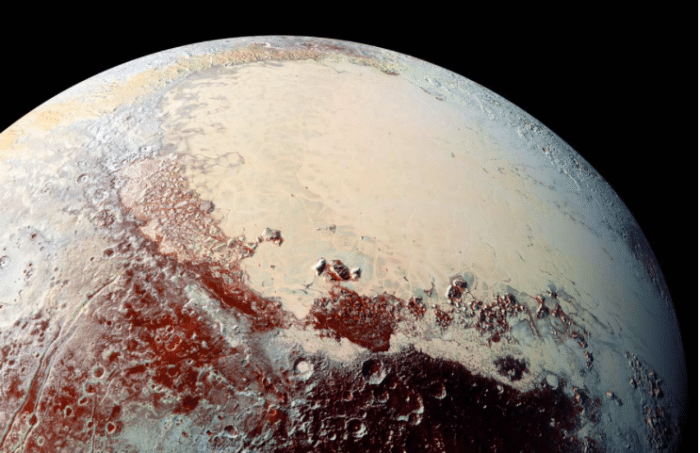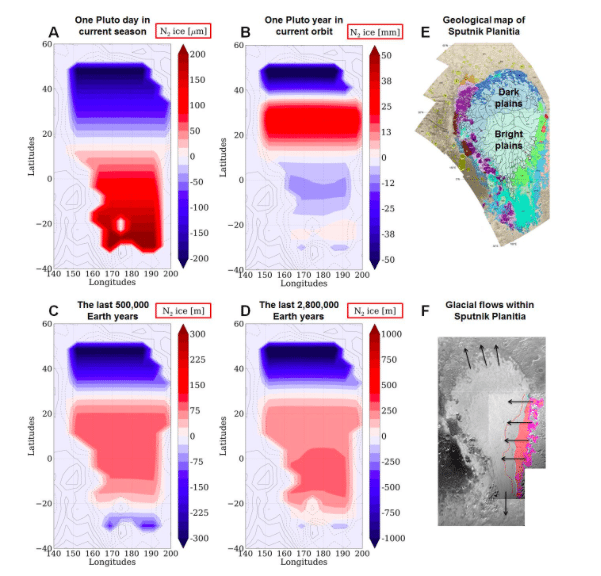
Numerical modeling of the nitrogen cycle on Pluto explains the distribution, color, geology, and morphology of the different nitrogen ice deposits observed.
On July 14, 2015, our vision of Pluto changed as the NASA New Horizons spacecraft flew by Pluto and revealed an active frozen world, with unprecedented landscapes in the Solar System. On the surface, vast plains covered with frost and spectacular glaciers, composed of different mixtures of volatile nitrogen ices, methane, and carbon monoxide, demonstrate the complexity and the geological diversity Pluto offers [1][2].
In particular, New Horizons observed a massive ice sheet of nitrogen ice, mixed with methane and CO, covering 5% of Pluto’s surface and supposed to be several kilometers thick. Surprisingly, this ice sheet did not form at the poles and at high altitude like Antarctica on Earth. On the contrary, it is located at the equator, at the bottom of a vast topographic basin called Sputnik Planitia. It displays a large diversity of terrains (deep pits, bright and dark plains, depressions, and glacial flows…), which suggest a complex history and an intense activity involving volatile and glacial processes occurring at different time scales [3].

The polar cap of « Sputnik Planitia », in false colors, is surrounded by mountains which have been eroded and shaped by the glacial activity. The dark areas are covered by organic materials produced by the photolysis of methane by solar ultraviolet light. © NASA/Johns Hopkins University Applied Physics Laboratory/Southwest Research Institute.
These exotic and enigmatic observations call upon modeling efforts to complete their analysis and understand the associated mechanisms at play in the atmosphere and at the surface of Pluto.
For this purpose, the authors of the paper developed a numerical model able to simulate Pluto’s atmosphere and surface, relying solely on universal physical principles [4][5][6].
The model is designed to simulate nitrogen ice transport over millions of years, taking into account the changes of obliquity, solar longitude of perihelion, and eccentricity as experienced by Pluto (on Earth, such Milankovitch cycles are responsible for the glacial-interglacial cycles). Using this model, the paper explores the volatile and glacial activity of nitrogen on Pluto on different timescales.
The results explain many geological features of the Sputnik Planitia ice sheet. They show that the thickness of the ice oscillates with the obliquity cycles and may increase or decrease by up to 1 km in 2 million years, leading to intense glacial flows eroding the surrounding water-ice mountains, which is consistent with the evidence of glacial flows around the ice sheet.
In addition, the results show that the southern latitudes of the ice sheet are dominated by sublimation at the annual timescale, explaining the small sublimation pits observed in these regions.
According to the model, the Sputnik Planitia ice sheet is currently at its minimum extent at the northern and southern edges.

Sublimation-condensation rates of N2 (zoom at Sputnik Planitia) at different timescales (note the order of magnitude differences between the colorbars, from μm to m): (A) During one Pluto day in July 2015. (B) During one Pluto year in current orbital conditions. (C) During the last 0.5 Myrs. (D) During the last 2.8 Myrs (obliquity cycle). (E) Geological map of the Sputnik Planitia region (a full resolution version can be found in White et al. (2017). (F) New Horizons mosaic of Sputnik Planitia, with recent glacial activity indicated by the red area. The purple line indicates the extent of the N2 ice sourced for the glaciation, the cyan line indicates the current ice deposition limit, and the red line indicates the inferred former ice deposition limit. The black arrows indicate the direction of the flow. Originally shown as Fig. 6 in Howard et al. (2017).
© NASA/Johns Hopkins University Applied Physics Laboratory/Southwest Research Institute/Laboratoire de Météorologie Dynamique. Republished with permission from Elsevier from: https://doi.org/10.1016/j.icarus.2018.03.012
The paper also demonstrates that perennial nitrogen deposits are not stable at the poles but rather in the equatorial regions, in particular in depressions. This is consistent with the observations of equatorial nitrogen ice deposits. Such deposits may subsist over tens of millions of years, but they should ultimately end trapped in Sputnik Planitia, except if other mechanisms help to resupply these reservoirs.
Finally, the paper explores if high values of atmospheric surface pressures were possible in Pluto’s past. Results show that the maximum surface pressure over millions of years should have remained in the range of Pascals. This suggests that Pluto never encountered conditions allowing liquid nitrogen to directly flow on its surface. Consequently, the numerous geomorphological evidence of past liquid flow observed on Pluto’s surface may rather be the result of liquid nitrogen that flowed at the base of thick ancient nitrogen glaciers, which have since disappeared.
These findings are described in the article entitled The nitrogen cycles on Pluto over seasonal and astronomical timescales, recently published in the journal Icarus. This work was conducted by T. Bertrand from Sorbonne Universités and the National Aeronautics and Space Administration, F. Forget from Sorbonne Universités, O.M. Umurhan, O.L. White, and K. Ennico from the National Aeronautics and Space Administration, W.M. Grundy from Lowell Observatory, B. Schmitt from the Université Grenoble Alpes, S. Protopapa from the University of Maryland and Southwest Research Institute, A.M. Zangari, K.N. Singer, A. Stern, L.A. Young, and C.B. Olkin from the Southwest Research Institute, P.M. Schenk from the Lunar and Planetary Institute, and H.A. Weaver from the Johns Hopkins University Applied Physics Laboratory.
References:
- Stern, S. A., et al., The Pluto system: Initial results from its exploration by New Horizons. Science, 350:aad1815, October 2015. doi: 10.1126/science.aad1815.
- Schmitt, B., et al., Physical state and distribution of materials at the surface of Pluto from New Horizons LEISA imaging spectrometer. Icarus, 287:229{260, May 2017. doi:10.1016/j.icarus.2016.12.025.
- White, O., et al., Geological mapping of Sputnik Planitia on Pluto. Icarus, 287:261-286, May 2017. doi: 10.1016/j.icarus.2017.01.011.
- Bertrand, T., and Forget, F., Observed glacier and volatile distribution on Pluto from atmosphere-topography processes. Nature, 987, December 2016. doi:10.1038/nature19337.
- Forget, F., et al., A post-new horizons global climate model of Pluto including the N2, CH4 and CO cycles. Icarus, 287:54{71, May 2017. doi: 10.1016/j.icarus.2016.11.038
- Bertrand, T., et al., The nitrogen cycles on Pluto over seasonal and astronomical timescales. Icarus, 309:277-296, July 2018. doi: 10.1016/j.icarus.2018.03.012.









